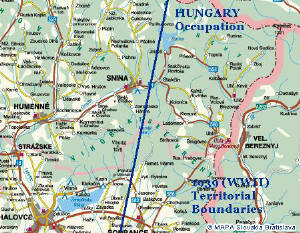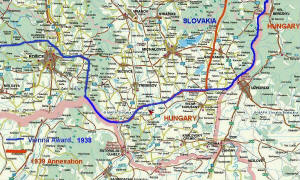| Slovakia Genealogy Research Strategies | ||||||
| Home | Strategy | Place Names | Churches | Census | History | Culture |
| TOOLBOX | Contents | Settlements | Maps | FHL Resources | Military | Correspondence |
| Library | Search | Dukla Pass | ||||
Additional Annexation of Eastern Slovakia by Hungary, 23-26 March 1939
Military History - Northeast Slovakia | Russian Offensive - Post Dukla | Snina Rock
1939 Annexation - Northeastern sector (top) Southeastern sector (bottom) |
Shortly after the Vienna Award of 1938, Hungary took advantage of the vulnerability of the newly-formed state of Slovakia in order to acquire more territory. In March, 1939, Hungary forcibly invaded Slovakia from the east, moving as far as it could until it was repelled by the Slovak Army.
The two maps shown here are illustrated with a demarcation line showing the line of Hungarian occupation after the additional annexation of lands from Slovakia (see below) before(in pink) and in March, 1939 (in blue). I have compiled the 1939 line based upon historical text, battle documents and imputation based on "Nazvy Obci Slovenskej Republiky" by Milan Majtan, 1998. While this line lacks exact border precision, it does properly portray the villages on each side of the annex demarcation. For a view of the wider context, see the Carrigan and Kuzych map. FUTURE TO BE ADDED
Vienna Arbitration Award
In November, 1938 the Vienna Arbitration Award served to ameliorate the longstanding border dispute between Czechoslovakia and Hungary. The Arbitration award was signed on November 2nd and the occupation occurred on the 5th and 10th of November, 1938. In part, it allowed to Hungary annex Ruthenia as well as southerly portions of present-day Slovakia containing majority Magyar populations.
Additional Annexation of Slovakia Lands by Hungary - Border Conflict
Subsequent to the Vienna award, on March 22-23, 1939 Hungarian troops moved westward (stopping just east of Snina). The first village to be occupied was Ubla, surprising and capturing a company of the 16th infantry Regiment of the Slovak Army. They attacked a line from Velky Bereznyj to Ulic and from Vysne Nemecke to Sobrance. the Slovak Army attempted to repel this invasion with two Army groups, "Stakcin" and "Michalovce." By March 25, the Slovak Army had assembled 15,000 troops in Michalovce. The Slovak Army counter attacked, the Hungarians held, and then the Hungarian Army proceeded with another counter attack. The stalemate just outside of Stakcin remained for the duration of the War. Hungary annexed this Slovakia territory Hungary without diplomatic agreement. Generally speaking, the north-south border ran from Poland in the north to the new south-east corner near Velke Kapusany, pushing eastward approximately 20 Km. (Reference V)
Here are some of the sources used, in addition to first-hand accounts.
Reference I - Veress, Laura-Louis: Clear the Line - Hungary's Struggle to Leave the Axis During the Second World War
"....While the leaders were negotiating, other patriots were taking more practical steps to regain the territories lost to Czechoslovakia..... .....On November 2, 1938, German and Italian leaders gathered in the Belvedere Palace near Vienna and decided to grant Hungary permission to regain part of the territories lost to Czechoslovakia. The benefit was much less than we had hoped, but the Hungarian Government decided to make the most of the situation and gave orders to march into Czechoslovakia. pushing beyond the boundaries set by the Vienna Accords, but taking pains to refrain from violence and brutality. Actually, there was no need for violence; the Slovak population was as glad as the Hungarians to be rid of the Czechs. Leslie marched with his regiment to occupy the lost regions."
Reference II - Paul Robert Magocsi, "The Rusyns of Slovakia", 1993
"A few weeks later (after the November annexation of the southern territories of Slovakia and the formation of Slovakia), the Hungarians also annexed a slice of eastern Slovakia which included 36 Rusyn villages (20,000) people from the Presov Region."
Reference III - Stanislav Kirschbaum, "A History of Slovakia"
"....However, the independence of Slovakia and the signing of the treaty (Treaty of Protection between Germany and Slovakia, 23 March 1939), had not prevented Hungary from trying, with German knowledge and consent, to acquire more territory at Slovakia's expense which the Hungarians expected Slovakia would not be able to defend. On 17 March, the Hungarians proposed to Bratislava a revision of the frontier between Slovakia and Ruthenia, which they had occupied on 15 March. Bratislava refused and Hungarian troops crossed into Slovak territory on 23 March to effect this revision; the Slovaks counterattacked the next day. Germany intervened and when negotiations opened on 27 March, Berlin backed the Hungarian demands. As a result, Slovakia ceded an area of 1.697 square kilometers and 69,639 inhabitants according to the 1938 census."
Reference IV - League of Nations Archives, Palais des Nations, CH-1211, Geneva 10, Switzerland
Center for the Study of Global Change, 201 N. Indiana Avenue, Bloomington, Indiana
(March 15, 1939) "The Hungarians, on the other hand, annexed Carpatho-Ukraine after heavy fighting began under Augustin Volosin. The Hungarians also secured a small slice Eastern Slovakia from the Germans."
Reference V - "Germany's First Ally, Armed Forces of the Slovak State 1939-1945", Kliment & Nakladal, 1997, Schiffer Publishing, Ltd.
Additional Resources
Edward Chaszar : The Czechoslovak-Hungarian Border Dispute of 1938
ADMIRAL MIKLÓS HORTHY: MEMOIRS Friction With Hitler
Wikipedia: Slowakisch-ungarischer Krieg (German)
Thanks to Laurence Krupnak for proofreading the Carrigan and Kuzych map site reference.
Links to off-site webs will open in a new window. Please disable your pop-up stopper.
Last Update: 15 November 2020 Copyright © 2003-2021, Bill Tarkulich

